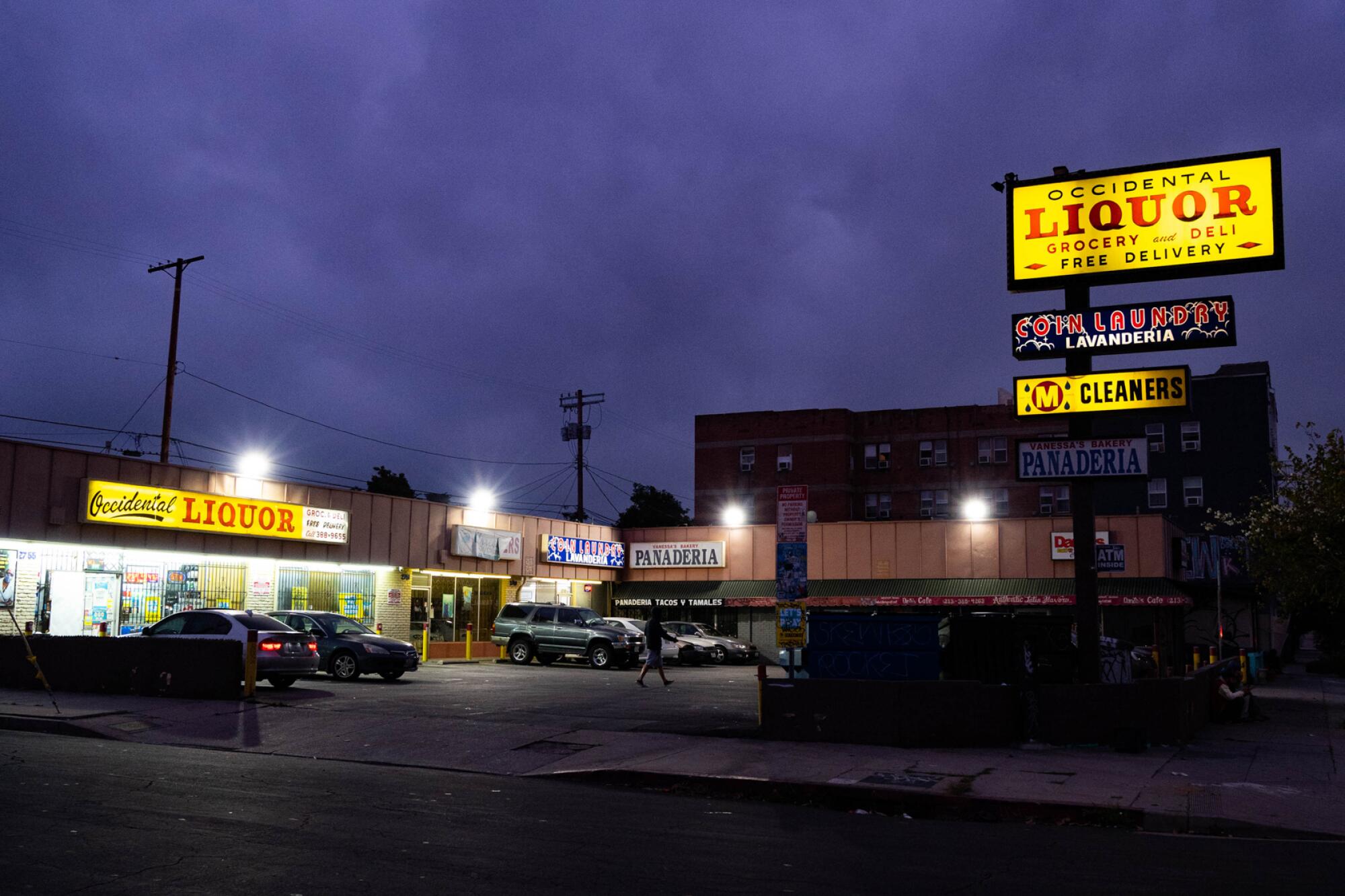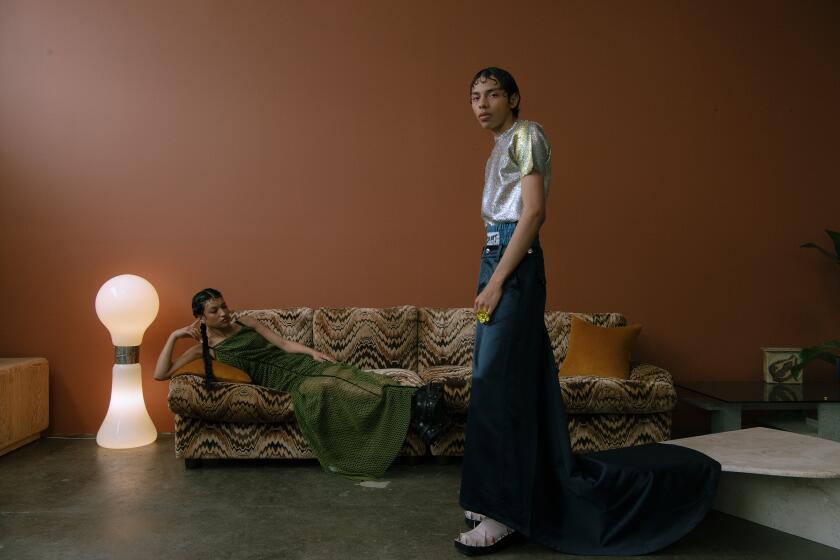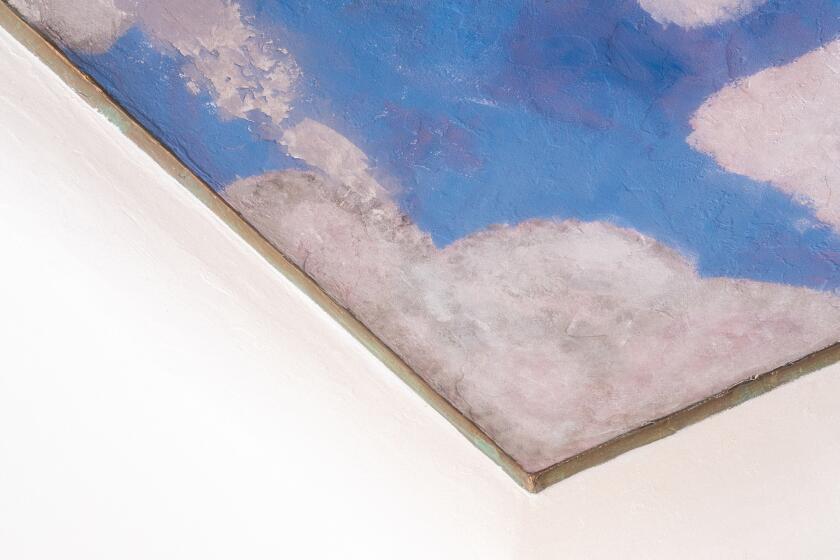
- Share via
This story is part of “Clearance,” a design issue that peels back the layers of aspirational architecture in L.A., and envisions a more beautiful future that lives a little less on the nose. Read the whole issue here.
Gloom had swallowed the sun, transforming the V-shaped corner strip mall into a gothic oasis. Half of its boxy storefronts were shuttered, plywood nailed over doors, windows, stucco and dreams. Happy Flowers, gone. Olympic Thai Restaurant, gone. Sushi Mama, gone. Santo’s Shoe Repair, rest in peace.
The witch knew that she could count on the strip mall for highly effective magic. She parked in the lot’s only vacant spot, and before walking into the mall’s most brightly lit business, Silly’s Smoke Shop, she got a funny feeling and stopped. She looked over her shoulder and saw a woman wearing a sleeping bag, both feet wrapped in shopping bags, shuffle past her car. After muttering at the sky, the woman in the sleeping bag blew a raspberry at it. The witch said a silent, quick prayer for her.
In Silly’s front window stood an artfully arranged display of glass bongs, pipes and one-hitters. The witch imagined what an earthquake could do to this shiny merchandise, the dangerous work that a temblor could create for whomever had to clean up the shards. The destruction would look beautiful. Shattered glass, when crunched very small, resembles teardrops.
MidcenturyLA is the kind of place made for manifesting.
The witch approached the counter. The cashier, who had been leaning against an air freshener display, walked to the large square cut into the plexiglass barrier meant to protect her from desperate people.
The witch asked, “Do you sell screens?”
The cashier turned away, briefly disappearing behind the barrier covered in stickers advertising energy drinks, tobacco products and unregulated aphrodisiacs. She reappeared holding a teensy black sleeve stuffed with round mesh screens, the kind that hold marijuana aloft in a bowl.
“These?”
“Yes.” The witch noticed that the cashier was wearing black latex gloves. Wise, she thought. Her gaze swept from the cashier’s hand to her face. Pretty. She reminds me of that girl. The Ethiopian one. The one with the elegant neck. The one who beat me at chess. She remembered the girl’s smile. She almost whispered her name. Hirut.
About the witch, the Hirut lookalike thought, Odd. I can’t tell how old she is. This woman might be 25. She might be 45. She could be 70.
“Anything else?”
“American Spirits.”
The cashier walked to a gently slanted rack bolted to the back wall. She gestured at the three types of American Spirits on display: blue, tan and black.
“Blue. Original blend.”
The cashier grabbed the first blue box. The one behind it slid quietly into its place.
“13.57.”
The witch reached into her camel bag. That was what her father called it. When he had given it to her, he had said, “Take good care of this. It has taken good care of me. I got it at a souk in Marrakech from a man with five teeth. I kept my passport, and other things, in it.” The camel bag had been the witch’s 21 birthday present. Inside it, she had found two more gifts, a PayDay candy bar and a lottery ticket.
“Thank you,” she had said to her father. “I’ll take good care of it. I promise.”
The witch moved her hand around in the camel bag, groping for the soft leather wallet stuffed with bills. Before coming to Silly’s, she had waited in a short line of one to use the ATM on the east end of the strip mall. The patron using the machine, a woman in plaid pants and a tight black shirt, had annoyed the witch. She had seemed to be dillydallying. The witch couldn’t make sense of her actions. The ATM stood inside a small glass enclosure, a roomy hut made of windows and steel, and the witch had watched the woman in plaid seemingly recycle cash. She made withdrawals and then deposited them, made withdrawals and then deposited them. As this nonsensical cycle had worn on, the witch had tried to imagine the face of the woman in plaid pants. She pictured her with brown eyes, like her youngest aunt. She assigned her pleasing features, a nose, a mouth and cheekbones that did not and could not suggest Europe.
When the woman in plaid finally turned around, her face had stunned the witch. She looked nothing like her youngest aunt. Instead, the woman in plaid pants had the face of an unbaked biscuit with a slit for a mouth. This was the face of an Ashley, Bridget or Erin. The Ashley, Bridget or Erin had tried to do something about her mouth, dab it with lip gloss, but the makeup had not helped. It could not create lips where there were none.
She should take some of that money, thought the witch, and buy herself a decent mouth. She had recalled a saying taught to her by her mother: “No hay gente fea, sólo hay gente pobre.”
The witch waited until the woman in plaid pants had exited the glass hut before entering it. When she stepped inside she felt something under her shoe, lost her balance and then thrust her arms out, stabilizing herself. She moved her foot aside: a green lighter. Near it were the remnants of what appeared to be a food and tobacco fight. Refried beans, ketchup, pickles and what might have been bacon were smeared across the tile floor. This Jackson Pollock mess was accented by broken cigarettes, small tufts of cottony filter and loose tobacco appearing here and there. Someone had savaged the mirror above the ATM. This reflective plastic stretched above the machine, the words “cash & deposits” stenciled across it. The witch looked up at it, at her reflection. She saw herself broken into jagged pieces.
The last time she’d heard glass break, her head had been used to shatter it. He — she hated to even think his name — had slammed her head into the long oval mirror hanging in his bathroom. She had protected her face by lowering her head, tucking her chin against her neck, and for days after she had harvested pieces of glass from her scalp. When she told her cousin Valentina what he had done, she offered to have her husband “take care of him,” but the witch had told her, “No, prima. I can handle it. He’ll be sorry.”
From the ATM, the witch had withdrawn $300.
“13.57,” repeated the cashier.
The witch handed her a 20.
Two more customers had entered Silly’s. One was bent over, examining metal pipes in a glass case. The other browsed a shelf stocked with snacks and other things people put in their mouths. Gum. Mouthwash. Toothpicks. Both customers were young men. They looked vibrant, not at all like him. He had looked, and smelled, like death. He was a creaky but dangerous man. He had stolen from her, humiliated her, and crowned her with a tiara made of glass shards. The witch was going to make sure that the last year of his life was his most miserable one. She was assembling the supplies needed to send suffering his way. At night, she would go to the cemetery. But first, she needed to gather Spanish moss, sulfur, hairspray, twine and candles.
The cashier returned the witch’s change, and she slid it into her camel bag. She headed for the exit and looked to her right before leaving. Framed posters hung on the wall. A heavily tattooed Marilyn Monroe smoking a cigar. A portrait of Emperor Haile Selassie riding a white stallion, his background awash in red, yellow and green.
The witch walked down gum-stained concrete, beneath narrow eaves. She inhaled at the doughnut shop, apple fritters, but ignored what remained of Happy Flowers, its sign with the big yellow daisy in place of the letter ‘O.’ She entered the strip mall’s westernmost business, Botanica Santa Teresa.
The witch’s madrina had introduced her to Santa Tere and since that first visit, she had become a loyal customer. Santa Tere’s supplies could always be counted on to get the job done, and everything in Santa Tere, including the walls and ceiling, was forever coated in a layer of candle soot. The botanica smelled of burning wax and incense, not unlike mass.
The witch walked along shelves carrying bottles with labels like Moneybringer and He Will Return to Me. At the back of Santa Tere, in a corner, stood a life-sized statue of Santa Muerte. Her skull wore a wig made of waist-length, lustrous human hair and above her eye sockets, which were studded with green rhinestones, someone had glued long, black eyelashes. Over her dress, she wore a red velvet cape, a la Little Red Riding Hood, but it was her dress that wowed. The gown was made of real money, hundreds of dollar bills meticulously folded and woven into a skirt and bodice. Offerings encircled Santa Muerte. Near her feet, a lock of hair. A can of Red Bull. A wilted rose. A teddy bear. A Snickers bar still in its wrapper. The witch approached the idol and slid a $100 bill between her skeletal fingers. After making an inverted sign of the cross, she headed toward the shop’s other rear corner, to the candles.
The witch reached into her bag, pulled out latex gloves, and put them on. Her madrina had taught her never to let black candles touch her skin. She chose two and carried them to the counter. The cashier, whose purplish eyebrows had been tattooed to her forehead, used a rag to handle the black candles, placing them in a paper bag and handing them to her customer. The witch set a $20 bill on the counter and said, “Gracias.”
“Buena suerte,” said the cashier.
From behind the counter, the cashier pulled forth a large brass hanging censer. She swung it back and forth, purifying the space, removing whatever evil the witch might have brought with her.
As the witch stepped into the parking lot, she looked up at the sky and smiled.Gray. All gray. A one-eyed crow was perched on the tall strip mall sign, above the word “insurance.” The bird let out a strangled caw and the earth began to gently shake. If all went well, she’d be returning with a hard-won gift to lay at the feet of the pretty skeleton wearing the neighborhood’s most impressive dress.
Myriam Gurba is the author of “Mean,” a ghostly memoir about survivorship that was selected as a New York Times Editors’ Choice. Her next book, “Creep: Accusation and Confessions,” will be released by Avid Reader Press in September.











